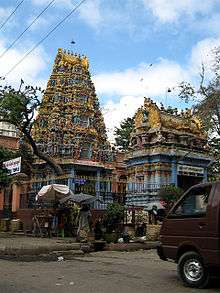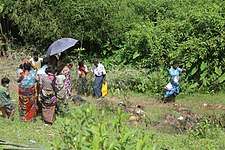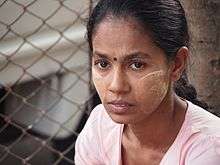Hinduism in Myanmar
| Historical Population(Census) | ||
|---|---|---|
| Year | Pop. | ±% |
| 1973 | 115,685 | — |
| 1983 | 177,215 | +53.2% |
| 2014 | 252,763 | +42.6% |
| *Only reports those who stated Hinduism, it is widely believed most did not reveal Hinduism as their religion due to societal and other pressures. **Estimated Real Population of 840,000 Hindus Source: http://myanmar.unfpa.org/sites/default/files/pub-pdf/UNION_2-C_religion_EN_0.pdf | ||
Hinduism in Myanmar is practised by about 252,763 people, however Pew Research estimates range from 820,000 to 840,000.[1] Hinduism in Myanmar has also been influenced by Buddhism with many Hindu temples in Myanmar housing statues of the Buddha.[2][3] Because a reliable census has not been taken in Burma since colonial times and most likely did not reveal their religion, estimates are approximate.
Demographics
| Year | Percent | Increase |
|---|---|---|
| 1973 | 0.4% | - |
| 1983 | 0.5% | +0.10% |
| 2014 (Likely Undercounted) | 0.5% | - |
| 2010 (Pew Research)[4] | 1.7% | - |
Population of Hindus by State/Region,according to the 2014 census[5]
| State/Region | Percent of Hindus |
|---|---|
| 2% | |
| 1% | |
| 1% | |
| 0.6% | |
| 0.5% | |
| 0.4% | |
| 0.2% | |
| 0.2% | |
| 0.1% | |
| 0.1% | |
| 0.1% | |
| 0.1% |
Ethnicity
Predominantly, Burmese Indians are Hindu. The practice of Hinduism among Burmese Indians is also influenced by Buddhism. In addition of Hindu deities, the Buddha is also worshiped and many Hindu temples in Myanmar house statues of the Buddha. The Burmese Indians include Myanmar Tamils, Bengalis, Odias, Malayalis, etc.
Many Burmese Gurkha in Myanmar practice Hinduism. Burmese Gurkhas are Nepali ethnic people.
The majority of the Meitei (or, Manipuri) practise Hinduism. They are descendants of those who were taken from Manipur as forced labourers during the Manipuri-Burmese war from 1819 to 1825. Manipuris are concentrated in about 13 villages of Mandalay, Sagaing and Amarapura areas. Manipuri settlements are also found along the Ningthi river, and the areas sandwiched between the river and the boundary of Manipur.
A small minority of Rohingyas are Hindus.
History
Hinduism, along with Buddhism, arrived in Burma during ancient times. Both names of the country are rooted in Hinduism; Burma is the British colonial officials' phonetic equivalent for the first half of Brahma Desha, the ancient name of the region.[6] Brahma is part of Hindu trinity, a deity with four heads. The name Myanmar is the regional language[7] transliteration of Brahma, where b and m are interchangeable.[6]
Arakan (Rakhine) Yoma is a significant natural mountainous barrier between Burma and India, and the migration of Hinduism and Buddhism into Burma occurred slowly through Manipur and by South Asian seaborne traders. Hinduism greatly influenced the royal court of Burmese kings in pre-colonial times, as seen in the architecture of cities such as Bagan. Likewise, the Burmese language adopted many words from Sanskrit and Pali, many of which relate to religion.
While ancient and medieval arrival of ideas and culture fusion transformed Burma over time, it is in 19th and 20th century that over a million Hindu workers were brought in by British colonial government to serve in plantations and mines. The British also felt that surrounding the European residential centre with Indian immigrants provided a buffer and a degree of security from tribal theft and raids. According to 1931 census, 55% of Rangoon's (Yangon) population were Indian migrants, mostly Hindus.[8]
After independence from Britain, Burma Socialist Programme Party under Ne Win adopted xenophobic policies and expelled 300,000 Indian ethnic people (Hindus), along with 100,000 Chinese, from Burma between 1963 and 1967. The Indian policy of encouraging democratic protests in Burma increased persecution of Hindus, as well as led to Burmese retaliatory support of left-leaning rebel groups in northeastern states of India.[8]
Contemporary status

Aspects of Hinduism continue in Burma today, even in the majority Buddhist culture. For example, Thagyamin is worshipped whose origins are in the Hindu god Indra. Burmese literature has also been enriched by Hinduism, including the Burmese adaptation of the Ramayana, called Yama Zatdaw. Many Hindu gods are likewise worshipped by many Burmese people, such as Saraswati (known as Thuyathadi in Burmese), the goddess of knowledge, who is often worshipped before examinations; Shiva is called Paramizwa; Vishnu is called Withano, and others. Many of these ideas are part of thirty seven Nat or deities found in Burmese culture.[9]
In modern Myanmar, most Hindus are found in the urban centres of Yangon and Mandalay. Ancient Hindu temples are present in other parts of Burma, such as the 11th century Nathlaung Kyaung Temple dedicated to Vishnu in Bagan.
Persecution of Hindus
After independence from Britain, Burma Socialist Programme Party under Ne Win adopted xenophobic policies and expelled 300,000 Indian ethnic people (Hindus), along with 100,000 Chinese, from Burma between 1963 and 1967.

On 25 August 2017, the villages in a cluster known as Kha Maung Seik in northern Maungdaw District of Rakhine State in Myanmar were attacked by Rohingya muslims of Arakan Rohingya Salvation Army (ARSA).This was called Kha Maung Seik massacre. Amnesty International said that about 99 Hindus were killed in that day.[10][11] Due to these, many Rohingya Hindus have started identifying themselves as Chittagonian Hindus rather than Rohingyas.[12]. In Myanmar and in Bangladeshi refugee camps—according to some media accounts—Hindu Rohingyas (particularly women) faced kidnapping, religious abuse and "forced conversions" at the hands of Muslim Rohingyas.
Hindu temples in Myanmar
See also
References
- ↑ Table: Religious Composition by Country, in Numbers Pew Research Center (December 2012)
- ↑ Natarajan, Swaminathan (6 March 2014). "Myanmar's Tamils seek to protect their identity". Retrieved 21 August 2018 – via www.bbc.com.
- ↑ Han, Thi Ri. "Myanmar's Hindu community looks west". Retrieved 21 August 2018.
- ↑ "Table: Religious Composition by Country, in Percentages". 18 December 2012. Retrieved 21 August 2018.
- ↑ https://drive.google.com/file/d/0B067GBtstE5TSl9FNElRRGtvMUk/view
- 1 2 Toʻ Cinʻ Khu, Elementary Hand-book of the Burmese Language, p. 4, at Google Books, pp. iv-v
- ↑ in both Talaing and Burmese languages; Prome is similarly derived from Brohm or Brahma.
- 1 2 Donald M. Seekins (2006), Historical Dictionary of Burma, ISBN 978-0810854765, pp. 216-220
- ↑ Thant Myint-U (2001), The Making of Modern Burma, Cambridge University Press, ISBN 978-0521799140, pp. 27-47
- ↑ "Rohingya militants slaughtered 99 Hindus in a single day: Amnesty International". Retrieved 21 August 2018.
- ↑ "Rohingya militants 'massacred Hindus'". 22 May 2018. Retrieved 21 August 2018 – via www.bbc.com.
- ↑ "'Don't call us Rohingya': Myanmarese Hindu refugees in Bangladesh detest the incorrect labelling - Firstpost". www.firstpost.com. Retrieved 21 August 2018.


